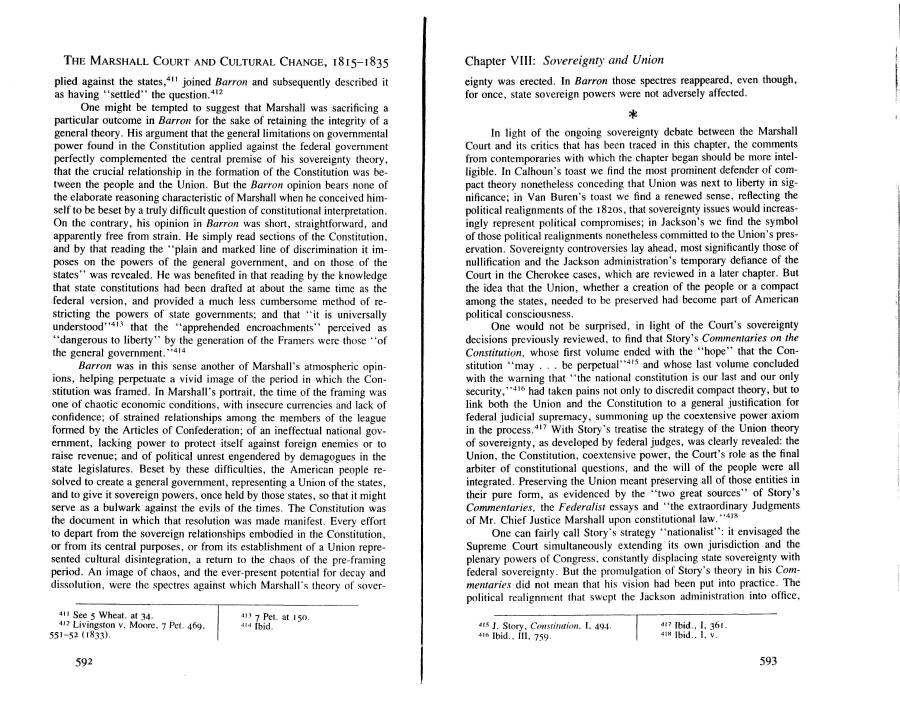|
THE MARSHALL COURT AND CULTURAL CHANGE, 1815-1835
plied against the states,411 joined Barron and subsequently described it
as having "settled" the question.412
One might be tempted to suggest that Marshall was sacrificing a
particular outcome in Barron for the sake of retaining the integrity of a
general theory. His argument that the general limitations on governmental
power found in the Constitution applied against the federal government
perfectly complemented the central premise of his sovereignty theory,
that the crucial relationship in the formation of the Constitution was be-
tween the people and the Union. But the Barron opinion bears none of
the elaborate reasoning characteristic of Marshall when he conceived him-
self to be beset by a truly difficult question of constitutional interpretation.
On the contrary, his opinion in Barron was short, straightforward, and
apparently free from strain. He simply read sections of the Constitution,
and by that reading the "plain and marked line of discrimination it im-
poses on the powers of the general government, and on those of the
states" was revealed. He was benefited in that reading by the knowledge
that state constitutions had been drafted at about the same time as the
federal version, and provided a much less cumbersome method of re-
stricting the powers of state governments; and that "it is universally
understood"413 that the "apprehended encroachments" perceived as
"dangerous to liberty" by the generation of the Framers were those "of
the general government."414
Barron was in this sense another of Marshall's atmospheric opin-
ions, helping perpetuate a vivid image of the period in which the Con-
stitution was framed. In Marshall's portrait, the time of the framing was
one of chaotic economic conditions, with insecure currencies and lack of
confidence; of strained relationships among the members of the league
formed by the Articles of Confederation; of an ineffectual national gov-
ernment, lacking power to protect itself against foreign enemies or to
raise revenue; and of political unrest engendered by demagogues in the
state legislatures. Beset by these difficulties, the American people re-
solved to create a general government, representing a Union of the states,
and to give it sovereign powers, once held by those states, so that it might
serve as a bulwark against the evils of the times. The Constitution was
the document in which that resolution was made manifest. Every effort
to depart from the sovereign relationships embodied in the Constitution,
or from its central purposes, or from its establishment of a Union repre-
sented cultural disintegration, a return to the chaos of the pre-framing
period. An image of chaos, and the ever-present potential for decay and
dissolution, were the spectres against which Marshall's theory of sover-
411 See 5 Wheat, at 34.
412 Livingston v. Moore, 7 Pet. 469,
551-52 (1833).
592
413 7 Pet. at 150.
414 Ibid.
Chapter VIII: Sovereignty and Union
eignty was erected. In Barron those spectres reappeared, even though,
for once, state sovereign powers were not adversely affected.
In light of the ongoing sovereignty debate between the Marshall
Court and its critics that has been traced in this chapter, the comments
from contemporaries with which the chapter began should be more intel-
ligible. In Calhoun's toast we find the most prominent defender of com-
pact theory nonetheless conceding that Union was next to liberty in sig-
nificance; in Van Buren's toast we find a renewed sense, reflecting the
political realignments of the 18205, that sovereignty issues would increas-
ingly represent political compromises; in Jackson's we find the symbol
of those political realignments nonetheless committed to the Union's pres-
ervation. Sovereignty controversies lay ahead, most significantly those of
nullification and the Jackson administration's temporary defiance of the
Court in the Cherokee cases, which are reviewed in a later chapter. But
the idea that the Union, whether a creation of the people or a compact
among the states, needed to be preserved had become part of American
political consciousness.
One would not be surprised, in light of the Court's sovereignty
decisions previously reviewed, to find that Story's Commentaries on the
Constitution, whose first volume ended with the "hope" that the Con-
stitution "may ... be perpetual"415 and whose last volume concluded
with the warning that "the national constitution is our last and our only
security,"416 had taken pains not only to discredit compact theory, but to
link both the Union and the Constitution to a general justification for
federal judicial supremacy, summoning up the coextensive power axiom
in the process.417 With Story's treatise the strategy of the Union theory
of sovereignty, as developed by federal judges, was clearly revealed: the
Union, the Constitution, coextensive power, the Court's role as the final
arbiter of constitutional questions, and the will of the people were all
integrated. Preserving the Union meant preserving all of those entities in
their pure form, as evidenced by the "two great sources" of Story's
Commentaries, the Federalist essays and "the extraordinary Judgments
of Mr. Chief Justice Marshall upon constitutional law."418
One can fairly call Story's strategy "nationalist": it envisaged the
Supreme Court simultaneously extending its own jurisdiction and the
plenary powers of Congress, constantly displacing state sovereignty with
federal sovereignty. But the promulgation of Story's theory in his Com-
mentaries did not mean that his vision had been put into practice. The
political realignment that swept the Jackson administration into office,
415 J. Story, Constitution, \, 494.
416 Ibid.. Ill, 759.
417 Ibid., I, 361
41X Ibid., I, v.
593
|

